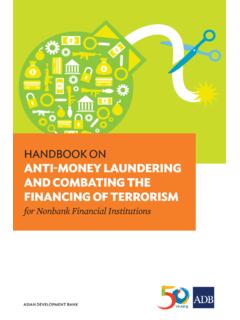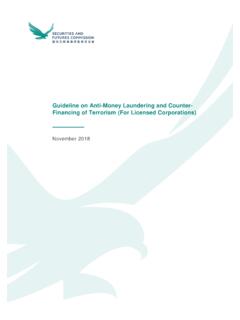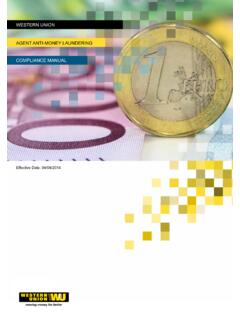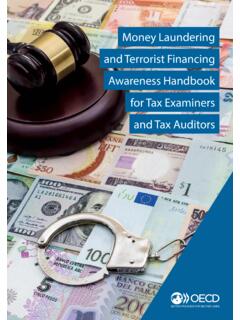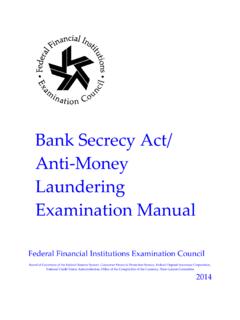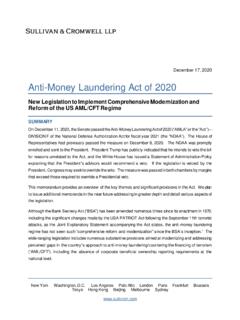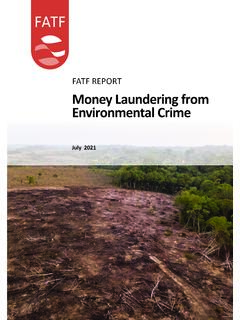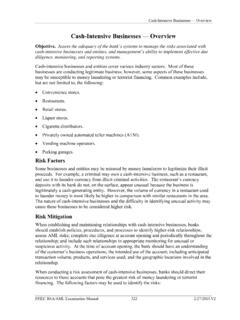Transcription of Trade-Based Money Laundering Risk Indicators
1 Trade-Based Money Laundering Risk Indicators March 2021. The Financial Action Task Force (FATF) is an independent inter-governmental body that develops and promotes policies to protect the global financial system against Money Laundering , terrorist financing and the financing of proliferation of weapons of mass destruction. The FATF Recommendations are recognised as the global anti- Money Laundering (AML) and counter-terrorist financing (CFT) standard. For more information about the FATF, please visit This document and/or any map included herein are without prejudice to the status of or sovereignty over any territory, to the delimitation of international frontiers and boundaries and to the name of any territory, city or area. The goal of the Egmont Group of Financial Intelligence Units (Egmont Group) is to provide a forum for financial intelligence unites (FIUs) around the world to improve co-operation in the fight against Money Laundering and the financing of terrorism and to foster the implementation of domestic programs in this field.
2 For more information about the Egmont Group, please visit the website: Citing reference: FATF Egmont Group (2020), Trade-Based Money Laundering : Risk Indicators , FATF, Paris, France, 2021 FATF/OECD and Egmont Group of Financial Intelligence Units. All rights reserved. No reproduction or translation of this publication may be made without prior written permission. Applications for such permission, for all or part of this publication, should be made to the FATF Secretariat, 2 rue Andr Pascal 75775 Paris Cedex 16, France (fax: +33 1 44 30 61 37 or e-mail: Photo credits cover photo Getty Images Trade-Based Money Laundering : RISK Indicators |1. Trade-Based Money Laundering : Risk Indicators The risk Indicators provided below are derived from a sampling of the data received by the FATF and the Egmont Group of FIUs in the course of the Trade-Based Money Laundering (TBML) project.)
3 The risk Indicators are designed to enhance the ability of public and private entities to identify suspicious activity associated with this form of Money Laundering . By no means is this a conclusive list. While several Indicators identified may not appear to have a direct or exclusive connection with TBML, and may be indicative of other forms of Money Laundering or another illicit activity, they may nonetheless be relevant when trying to identify TBML. Before using the risk Indicators , readers are encouraged to read the handling notes below and the 2020 FATF/Egmont TBML report, which provides a comprehensive overview of current TBML risks and outlines a number of best practices in mitigating these risks . Trade-Based Money Laundering Trends and Developments This joint FATF-Egmont report aims to help public and private sector with the challenges of detecting Trade-Based Money Laundering .
4 Using numerous case studies from around the FATF's Global Network, it explains the ways in which criminals exploit trade transactions to move Money , rather than goods. It highlights recommendations to address the Trade-Based Money Laundering risks . These include using national risk assessments and other risk- focused material to raise awareness with the public and private sector entities involved in international trade , improving information-sharing of financial and trade data, and cooperation between authorities and private sector, including through public- private partnerships. FATF, Egmont Group (2020). Readers may also want to familiarise themselves with a suite of previous TBML. studies done within the FATF Global Network, such as a 2006 report on TBML, 1 a 2008. best-practices paper, 2 and a 2012 typologies report by the Asia Pacific Group on Money Laundering .
5 3. 1 2 3 2021 | FATF EGMONT GROUP. 2 | Trade-Based Money Laundering : RISK Indicators . Audience and how risk Indicators can be used A risk indicator demonstrates or suggests the likelihood of the occurrence of unusual or suspicious activity. The existence of a single indicator in relation to a customer or transaction may not alone warrant suspicion of TBML, nor will the indicator necessarily provide a clear indication of such activity, but it could prompt further monitoring and examination, as appropriate. Similarly, the occurrence of several Indicators could also warrant closer examination. Whether one or more of the Indicators suggests TBML is also dependent on the business lines, products or services that an institution offers; how it interacts with its customers; and on the institution's human and technological resources.
6 The Indicators listed below are relevant to both the public and private sectors. With respect to the latter, the Indicators are relevant to financial institutions, including banks and Money value transfer services; designated non-financial businesses and professions; and small and mid-size businesses and large conglomerates. Within the private sector, these Indicators are intended to be used by personnel responsible for compliance, transaction monitoring, investigative analysis, client onboarding and relationship management, and other areas that work to prevent financial crime. Some of the risk Indicators require the cross-comparison of various data elements ( financial transactions, customs data, and open market prices) often held in external sources. Due to this reliance on external data, the private sector will not observe all of the Indicators identified below.
7 For some of the risk Indicators , the private sector will need additional contextual information from competent authorities, via engagement with law enforcement authorities or financial intelligence units. In using these Indicators , private sector entities should also take into consideration the totality of the customer profile, including information obtained from the customer during the due diligence process, trade financing methods involved in the transactions, and other relevant contextual risk factors. 2021 | FATF-EGMONT GROUP. Trade-Based Money Laundering : RISK Indicators |3. Structural risk Indicators The corporate structure of a trade entity appears unusually complex and illogical, such as the involvement of shell companies or companies registered in high-risk jurisdictions. Acompliance. trade entity is registered or has offices in a jurisdiction with weak AML/CFT.
8 Entity is registered at an address that is likely to be a mass registration address, high-density residential buildings, post-box addresses, commercial buildings or industrial complexes, especially when there is no reference to a specific unit. 4. The business activity of a trade entity does not appear to be appropriate for the stated address, a trade entity appears to use residential properties, without having a commercial or industrial space, with no reasonable explanation. Aactivity trade entity lacks an online presence or the online presence suggests business inconsistent with the stated line of business, the website of a trade entity contains mainly boilerplate material taken from other websites or the website indicates a lack of knowledge regarding the particular product or industry in which the entity is trading.
9 Apayroll trade entity displays a notable lack of typical business activities, it lacks regular transactions in line with the number of stated employees, transactions relating to operating costs, tax remittances. Owners or senior managers of a trade entity appear to be nominees acting to conceal the actual beneficial owners, they lack experience in business management or lack knowledge of transaction details, or they manage multiple companies. Amoney trade entity, or its owners or senior managers, appear in negative news, past Laundering schemes, fraud, tax evasion, other criminal activities, or ongoing or past investigations or convictions. Avolume trade entity maintains a minimal number of working staff, inconsistent with its of traded commodities. corporation The name of a trade entity appears to be a copy of the name of a well-known or is very similar to it, potentially in an effort to appear as part of the corporation, even though it is not actually connected to it.
10 A trade entity has unexplained periods of dormancy. An entity is not compliant with regular business obligations, such as filing VAT returns. 4. This may also include the address of a trust and company service provider that manages a number of shell companies on behalf of its customers. 2021 | FATF EGMONT GROUP. 4 | Trade-Based Money Laundering : RISK Indicators . trade activity risk Indicators trade activity is inconsistent with the stated line of business of the entities involved, , a car dealer is exporting clothing or a precious metals dealer is importing seafood. Aintermediaries trade entity engages in complex trade deals involving numerous third-party in incongruent lines of business. Ainconsistent trade entity engages in transactions and shipping routes or methods that are with standard business practices. Ausetrade entity makes unconventional or overly complex use of financial products, of letters of credit for unusually long or frequently extended periods without any apparent reason, intermingling of different types of trade finance products for different segments of trade transactions.










